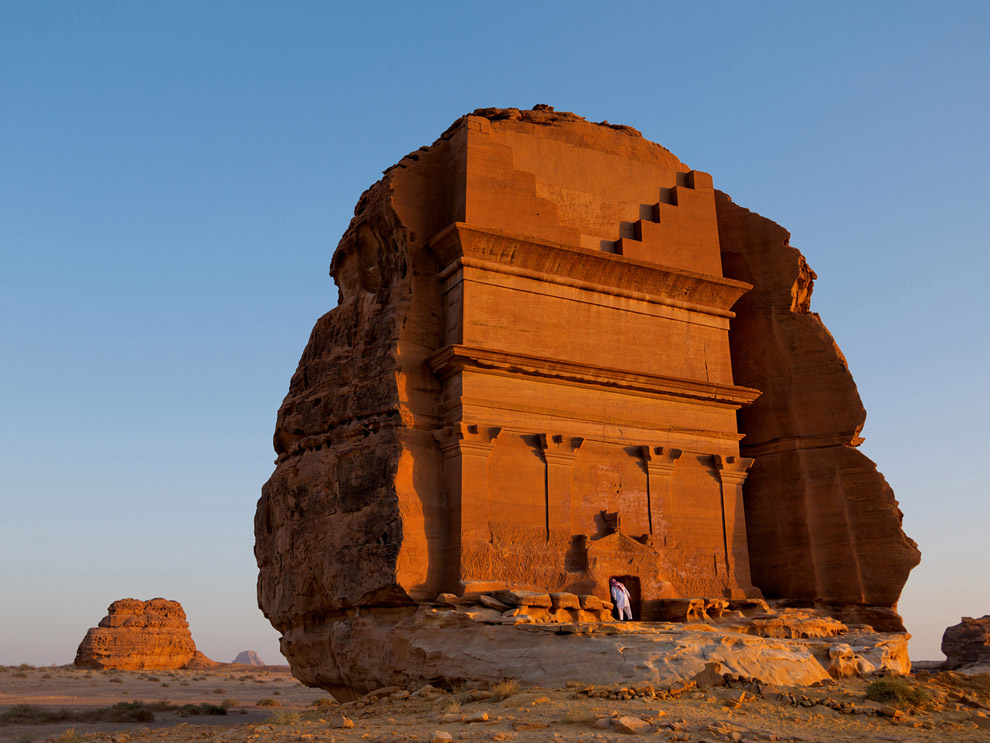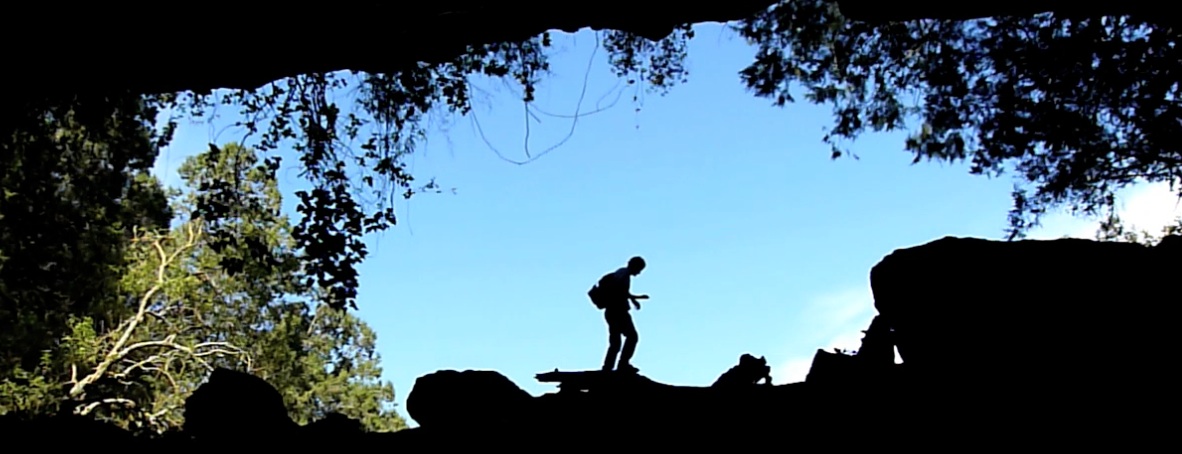
It has been said that one way to remember is to trace your steps. Pulitzer Center grantee Paul Salopek is in the midst of a seven-year voyage during which he will retrace the steps of mankind, from Africa to South America, in the Out of Eden Walk. His hope is that in walking in the footsteps of humanity, he will be able to relive one of the most important journeys of human history.
National Geographic, a funder of the Out of Eden Walk, is publishing the next installment of Salopek's amazing journey in its July 2014 issue. The piece, entitled "The Wells of Memory" recounts his passage through the Hejaz desert of Saudi Arabia. During his passage, Salopek encounters several individuals struggling to reconcile memories of their homeland with the realities of the new Middle East.
Below is an excerpt from Salopek's piece:
The Hejaz—a crossroads where Arabia, Africa, and Asia meet, and long tied by trade to Europe—is one of the most storied corners of the ancient world. It has seen millennia of wanderers. Stone Age people hunted and fished their way north out of Africa through vanished savannas. People from some of humankind's first civilizations—Assyrians, Egyptians, and Nabataeans—roamed through here, trading slaves for incense and gold. Romans invaded the Hejaz. (Thousands of the legionaries died of disease and thirst.) Islam was born here, in the dark volcanic hills of Mecca and Medina. Pilgrims from Morocco or Constantinople probably drank from the well in Wadi Wasit. Lawrence of Arabia may have gulped its water too. Nobody knows. Kadim jidn.
"Take it!" the running man says. He shoves his orphan finds at us. "Take it for free!" But we decline to buy his curiosities.
Packing our two camels to leave, we spot him once again. He is running now—sprinting around the well. He has removed his white robe. And he is running through the desert in his underwear, circling the well under the ruthless sun. He runs with abandon. Ali al Harbi, my translator, takes a photograph. Awad Omran, our camel handler, guffaws. But I cannot laugh. He is not mad, the running man. Or drugged. Or playing some joke. He is lost, I think. As we all are when we abandon history. We don't know where to go. There is an abundance of pasts in the Hejaz. But I have never been to a place more memory-less.
A small, bottomless well in the Hejaz: a white porcelain cup.
It holds dark, rich coffee. It sits atop a polished wooden table inside an elegant mansion in the port of Jeddah. Three articulate Hejazi women refill the cup endlessly. They take turns talking, wishing to correct misperceptions about Saudi Arabia: that the kingdom is a homogenized society, a culture flattened by its famously austere brand of Islam, a nation rendered dull by escapist consumerism and by petrodollars. No.
Saudi Arabia, they say, is a rich human mosaic. It enfolds many distinctive regions and cultures: a Shiite east, a Yemeni south, a Levantine north, and a tribal Bedouin stronghold in the center—the puritanical redoubt of the Najdis, home of the ruling dynasty, the House of Saud. The women insist, moreover, that no region in Saudi Arabia remains more independent, more proud, than the realm that has guarded the holy cities of Mecca and Medina since the tenth century—the vanished kingdom of the Hejaz. Fully independent by the end of World War I, the Hejaz was annexed by the Al Saud dynasty only in 1925. It remains a place of contradictions, of complexity, of tensions between religion and geography. On the one hand: a sacred landscape, its holy cities long forbidden to nonbelievers. On the other: the most cosmopolitan and liberal corner of Saudi Arabia, a melting pot, an entrepôt and nexus of migration, brightly checkered with influences from Asia, Africa, the Levant, and a hundred other places—the California of Saudi Arabia.
Laila Abduljawad, a cultural preservationist: "The Hejaz has attracted pilgrims from every corner of the Islamic world. How could this not rub off? Our main dish is Bukhari rice from Central Asia! Our folk textiles are Indian! Our accents are Egyptian! We are more open to the world than the people from the center."
Salma Alireza, a traditional embroiderer: "The traditional dress for women in the Hejaz was not the abaya"—the severe black robe imposed by the ruling Najdis. "Women here used to wear bright red and blue dresses in public. That was traditional. But life changed in the 1960s. The oil money poured in. We modernized too fast. We lost so much in 50 years!"
Rabya Alfadl, a young marketing consultant: "Is the Hejaz still different? Take a look around."
And it's true. The women sit at the table unveiled. They wear casual Western clothing: blouses and trousers. (Such a meeting would be difficult to arrange in the Saudi capital, Riyadh, where gender segregation and tribal ways remain so strict that a man will not utter his mother's name in public.) The house where we chat is sleekly designed, chic, minimalist, global in decor. And outside, in Jeddah's streets, there are art galleries, cafés, promenades, museums—the cultural hub of Saudi Arabia.
"A sense of cultural identity has persisted in the Hejaz for a thousand years. It developed its own music, its cuisine, its own folktales," Abduljawad tells me. She turns her cup in her hands. "We are taking our first baby steps to rescue a small part of this."
These women are daughters of a feminine city. Arab folk tradition holds that the biblical Eve was buried in Jeddah, now a modern, sprawling, industrial port. Eve's tomb—200 yards long, shaped like a reclining figure—was crowned by an "ancient and lofty dome," according to the Moorish traveler Ibn Jubayr. It is gone, marked today by a barren concrete cemetery. Wahhabi clerics, who abhor shrines as idolatrous, likely razed it nearly a century ago. But again, no one can remember.
Follow Along
Follow Paul on social media for updates, pictures of camels and more. You can find him on Facebook as well as Twitter @PaulSalopek, and the project is @outofedenwalk. You can also find him on Instagram @outofedenwalk. Furthermore, there is a new "Out of Eden" Youtube channel that followers can subscribe to.
Tools for Educators
Interested in making Paul's walk an educational experience for students? The Pulitzer Center education department put together lesson plans and maps for students of all ages; visit National Geographic's hub page for more.
Want to go even further? Contact the Pulitzer Center's education department(globalgateway AT pulitzercenter DOT org) to schedule class Skype sessions — these are only available when Paul is in Internet-ready areas. However, Paul is not the only journalist who can visit classrooms. The Pulitzer Center has connections with journalists all over the globe and lesson plans for plenty of topics. If you are interested in bringing a journalist to your school, please contact us.
In the meantime, remember to slow down—"To think. To write. To render current events as a form of pilgrimage." And keep Paul's journey in mind.
See also
Trip Update: Walking Out of Digital Africa
Edge of the World



